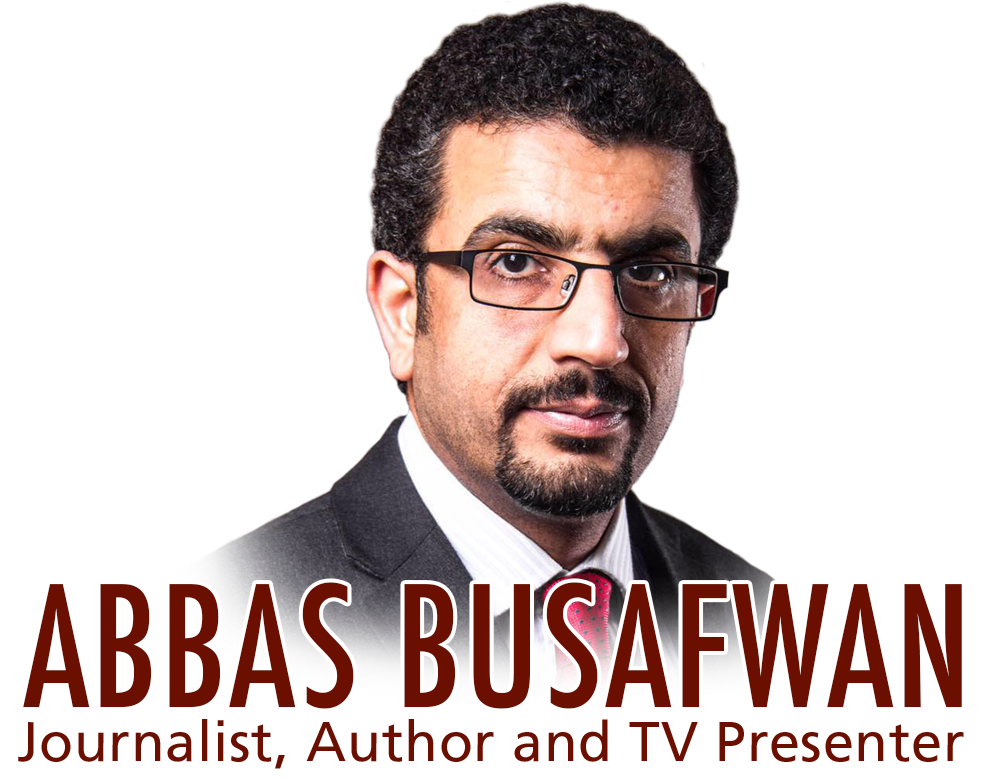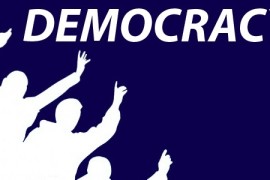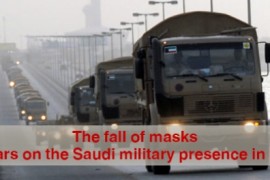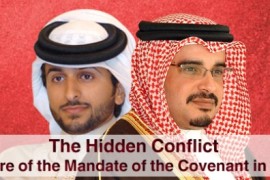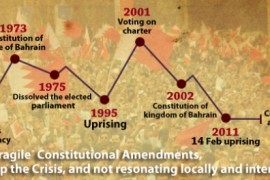To download the book, click here
Dedication
To the martyrs of the Pearl Revolution, may they always be remembered.
Table of Contents
Introduction
- Chapter One: HYPOTHESIS, The King is the Cause of the Crisis
- A study of the Motives calling for the Fall of the Monarchy
- Chapter Two: The Prime Minister… The Cortex of Dictatorship
- The King Stifles the Prime Minister in his “Constitutional” Den
- Consensuson Removing the Prime Minister
- Sunni Groups are not Loyal to the Prime Minister
- The King and the Prime Minister: The Public Clash
- Chapter Three: The Crown Prince, the Advocate of His Father’s Approach
- What is said about the Exclusion of the Crown Prince
- The Hidden Conflict: the Future of the Mandate of the Covenant in Bahrain
- Chapter Four: The Rule of Militancy… A Review of the King’s Speeches
- Power Parity Produces Inertia
- It is Not the Time Yet for Democracy!
- King Hamad and the People ‘Face to Face’
- Chapter Five: Bahrain Independent Commission of Inquiry (BICI) and the Dismantling of the Infrastructure of Tyranny
- Bassiouni’sRecommendations: A Recipe to Bring Down the Regime
- Chapter six: A Future Vision
- Possible Scenarios of Settlement
- Conclusion
- Appendix
Introduction
The international media usually holds the Prime Minister Khalifa bin Salman Al Khalifa (1935, …) accountable for the corruption and dictatorship dominating Bahrain. He is perceived as an impediment to the assumed democratic development adopted by the King Hamad bin Isa Al Khalifa (1950, …), and his eldest son the Crown Prince Salman (1969, …).
The main discourse of the opposition (Al Wefaq and other political societies) usually focuses on the slogan “Step down Khalifa”. This sentiment is also welcomed in the West as King Hamad, has instigated a number of constitutional and political procedures, including the restructuring of the ruling elite, in order to limit the powers of his uncle, Shaikh Khalifa.
In recent years the non-licensed political groups (Al Wafa, Haq and Al Ahrar) or what is known in Bahrain as the forces of “objection”, alongside active youth groups, who started the uprising of February 14, 2011, adopted the slogan “Down with Hamad” by passing the slogan “step down Khalifa”. The political societies preferred working within the project of King Hamad that was promising, according to the various justifications for engaging in it.
The chapters of this book compare the actions of King Hamad, and those of his uncle, in an attempt to test the following hypothesis: King Hamad bears complete responsibility for the ongoing deterioration in Bahrain, and not the Prime Minister, who is a dictator.
As a journalist and observer of the political scene during the past fifteen years, who closely witnessed the course of events, I can state that the notorious Prime Minister is not responsible for the path taken by Bahrain in the last fifteen years when King Hamad took over the reins of power and the initiative[1] in the country.
This may not be known to the public, the diplomatic corps and those concerned about the Bahraini case during the early years of the reign of the new king. Over the years I encountered a lot of opposition when I advanced the hypothesis that the prime minister has no power whatsoever.
It seems likely that some parties in the opposition are aware that the Prime Minister has been outside the circle of decision making since the king first became ensconced in the royal palace. The minister of his office became Khalid bin Ahmed Al Khalifa, the strong man in the country.
However, the understanding of the opposition societies in the balance of power in government circles, and the nature of their understanding of the regional and international vision of Bahrain, in addition to the usual thinking of the official opposition which is characterized by caution [2], prompts the opposition to demanding the stepping down of the Prime Minister, rejecting the slogan of “Down with Hamad” , to avoid open confrontation with the regime.
The reader will find in the following chapters observations and analysis of the overall steps and projects carried out by the king, which he sought to implement in the first decade of his reign, (what writers call the strategy of Hamad). It is believed that this strategy produced a massive popular revolution, essentially rejecting this monopolistic, exclusionary, Bandari strategy (relative to Al Bandar report).
The reign of Sheikh Khalifa of Bahrain was based on an iron fist between the years of 1971 and 1999[3]. During this time he skillfully manipulated the different interests of groups and strata of the people. This enabled him to neutralize the technocrats, the middle class, the traders, and the traditional families and prevent them from firmly engaging against his tyranny.
However, the “cleansing” practices of King Hamad towards the opposition and large sections society, issuing a constitution without consultation, permitting wide scale naturalization of foreigners, and targeting anyone with a different point of view, because he believed that the Shiites constitute a strategic threat to the regime, contributed to a shift in public opinion from venerating the king in 2001[4] to calling for his overthrow in 2011.
The King has chosen the doctrine of “walking on the edge of the abyss,” and adopting a policy of “either me or the opposition.” He succeeded at the beginning of his reign in paralyzing his opponents when he stunned them in 2001, by adopting a series of affirmative historic actions[5], as they were described at the time. The opposition was confused as it felt it had to keep pace with the rapidly introduced concessions. But the king’s strategy was exposed when he stopped the ball he set in motion and reversed the security and political situation to that of the 1950s when the national movement called for a full democratic system[6].
In contrast to what is believed, the slogan of “Down with Hamad” has been raised on the first day of the events of 14 February (2011). These were the words of the mother of Ali Mushaima[7], near the Salmaniya Medical Complex SMC gate[8], where this slogan was continually chanted.
The coming chapters will analyze the visions of the king regarding himself and the army, what he thinks of his kingdom, and the convergence of some of his speeches during the crisis, showing that he refused democracy, moderation and popular participation in the decision making process.
In the light of these complexities, the Crown Prince played different roles but he always remained faithful to his father’s approach. In the first stage of his reign his father used him to undermine his uncle, the Prime Minister, and entrusted him with managing the economic file, as well as using him during the months of February and March 2011 to absorb the anger of the protesters and explore their intentions, under the guise of dialogue.
Since the demolition of the Pearl Roundabout on 18 March 2011, the Crown Prince, has played a role described as the “Senior Director of the Public Relations” of the ruling family, and a strong defender of the dictatorship-based approach in a liberal way due to his failure during the past ten years to establish deep and broad relationships with the tribes and traders. He only has good relations with an isolated elite.
The displacement of Sheikh Khalifa, which is imminent either by a royal process or by God’s will, will continue to be a reminder that the political system in Bahrain is hard to reform, and that the Prime Minister is its cortex.
However, the King’s goal of the declaration of the “reform project” as a ploy for re-concentrating power in his hand, away from the Prime Minister, and not for the creation of a popular partnership and a democratic life, has become clear. Given his strategy which harmed the historical experience of Bahrain in a way that no other Khalifi ruler did before, and after his failure to contain the movement of 14 February, the scenario of overthrowing King Hamad cannot be excluded. This is verified by the experience of history when the first Hamad[9] (1872-1942) replaced his father Sheikh Isa bin Ali[10] (1847-1932) in the twenties of the last century, by a British decision, after popular and bitter complaints of corruption and human rights violations, while the Saudi family -the main obstacle to a real change in Bahrain- isolated the second king of the Kingdom of Saudi Arabia, Saud bin Abdulaziz Al Saud (1902-1969), in 1963.
Footnotes:
- To be a governor does not mean to be in control of the political decision, as in the case of the Amir Isa bin Salman AlKhalifa, who was a “ceremonial” prince while his brother, Prime Minister Khalifa bin Salman was the actual decision maker. In the case of King Hamad -and the group that obeys his orders- he has the power to make a decision already.
- In its expression of the public position and political demands, the official opposition led by AlWefaq make sure to avoid an open war with the regime, and to maintain a good relationship with the West, unlike the “radical/objection” groups who focus their energies on the political demand, and rarely take into account the local and international contexts.
- SheikhKhalifa was appointed as prime minister in August 15, 1971, and officially ruled the country until King Hamad held his position as the prince of Bahrain in March 1999.
- The (Prince) Hamad visitedSitra Island -which is a major stronghold of the opposition- in February 2001, as part of a campaign to promote his new policies then, and he was warmly welcomed by the residents there, and attempts were recorded to hold up his car as an expression of welcoming the visions of the new ruler.
- Emptying the prisons, allowing those displaced from the country to return, abolishing the law and courts of the security state, allowing partisan political action, and promising of the return of the democratic life.
- For more details on the events of the fifties of the last century, see: Abdul Rahman Al Baker, from Bahrain to exile.
- Shot and killed by shotgun in February 14, 2011, and is seen as the first victim of regime’s violence in the last uprising.
- It is not surprising that the workers in this hospital have been punished, because it has embraced the first political slogans against the king in this public manner.
- Sheikh Hamad bin Isa bin Ali AlKhalifa ruled Bahrain between 1923 -1942.
- Shaikh Isa bin Ali binKhalifa bin Salman bin Ahmed Al Fateh, the first ruler of the tribe of Al-Khalifa in Bahrain). He ruled Bahrain between 1869-1923.
